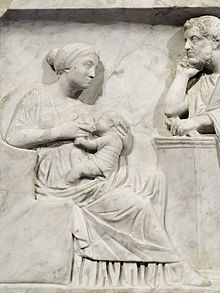
Back فهرست خدایان رومی تولد و دوران کودکی Persian ꯌꯨꯒꯦꯇꯤꯅꯨꯁ MNI Lista de deidades romanas do nascimento e da infância Portuguese Боги детства в римской религии Russian 伊特耳基多纳 Chinese

In ancient Roman religion, birth and childhood deities were thought to care for every aspect of conception, pregnancy, childbirth, and child development. Some major deities of Roman religion had a specialized function they contributed to this sphere of human life, while other deities are known only by the name with which they were invoked to promote or avert a particular action. Several of these slight "divinities of the moment"[1] are mentioned in surviving texts only by Christian polemicists.[2]
An extensive Greek and Latin medical literature covered obstetrics and infant care, and the 2nd century Greek gynecologist Soranus of Ephesus advised midwives not to be superstitious. But childbirth in antiquity remained a life-threatening experience for both the woman and her newborn, with infant mortality as high as 30 or 40 percent.[3] Rites of passage pertaining to birth and death had several parallel aspects.[4] Maternal death was common: one of the most famous was Julia, daughter of Julius Caesar and wife of Pompey. Her infant died a few days later, severing the family ties between her father and husband and hastening the civil war that ended the Roman Republic.[5] Some ritual practices may be characterized as anxious superstitions, but the religious aura surrounding childbirth reflects the high value Romans placed on family, tradition (mos maiorum), and compatibility of the sexes.[6] Under the Empire, children were celebrated on coins, as was Juno Lucina, the primary goddess of childbirth, as well as in public art.[7] Funerary art, such as relief on sarcophagi, sometimes showed scenes from the deceased's life, including birth or the first bath.[8]
Only those who died after the age of 10 were given full funeral and commemorative rites, which in ancient Rome were observed by families several days during the year (see Parentalia). Infants less than one year of age received no formal rites. The lack of ritual observances pertains to the legal status of the individual in society, not the emotional response of families to the loss.[9] As Cicero reflected:
Some think that if a small child dies this must be borne with equanimity; if it is still in its cradle there should not even be a lament. And yet it is from the latter that nature has more cruelly demanded back the gift she had given.[10]
- ^ Giulia Sissa, "Maidenhood without Maidenhead: The Female Body in Ancient Greece," in Before Sexuality: The Construction of Erotic Experience in the Ancient Greek World (Princeton University Press, 1990), p. 362, translating the German term Augenblicksgötter which was coined by Hermann Usener.
- ^ Mary Beard, J.A. North, and S.R.F. Price, Religions of Rome: A Sourcebook (Cambridge University Press, 1998), vol. 2, p. 33.
- ^ M. Golden, "Did the Ancients Care When Their Children Died?" Greece & Rome 35 (1988) 152–163; Keith R. Bradley, "Wet-nursing at Rome: A Study in Social Relations," in The Family in Ancient Rome: New Perspectives (Cornell University Press, 1986, 1992), p. 202; Beryl Rawson, Children and Childhood in Roman Italy (Oxford University Press, 2003), p. 104.
- ^ Anthony Corbeill, "Blood, Milk, and Tears: The Gestures of Mourning Women," in Nature Embodied: Gesture in Ancient Rome (Princeton University Press, 2004), pp. 67–105.
- ^ Rawson, Children and Childhood in Roman Italy, p. 103.
- ^ Rawson, Children and Childhood in Roman Italy, p. 99.
- ^ Rawson, Children and Childhood in Roman Italy, p. 64.
- ^ Rawson, Children and Childhood in Roman Italy, pp. 101–102.
- ^ Rawson, Children and Childhood in Roman Italy, p. 104.
- ^ Cicero, Tusculan Disputations 1.93,as cited by Rawson, Children and Childhood in Roman Italy, p. 104.
© MMXXIII Rich X Search. We shall prevail. All rights reserved. Rich X Search